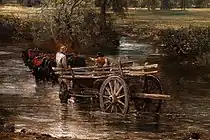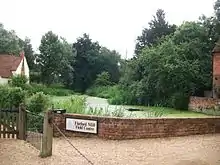The Hay Wain
The Hay Wain – originally titled Landscape: Noon – is a painting by John Constable, completed in 1821, which depicts a rural scene on the River Stour between the English counties of Suffolk and Essex.[1][2] It hangs in the National Gallery in London and is regarded as "Constable's most famous image"[3] and one of the greatest and most popular English paintings.[4]
| The Hay Wain | |
|---|---|
.jpg.webp) | |
| Artist | John Constable |
| Year | 1821 |
| Medium | Oil on canvas |
| Dimensions | 130.2 cm × 185.4 cm (51+1⁄4 in × 73 in) |
| Location | National Gallery, London |
Painted in oils on canvas, the work depicts as its central feature three horses pulling what appears to be a wood wain or large farm wagon across the river. Willy Lott's Cottage, also the subject of an eponymous painting by Constable, is visible on the far-left. The scene takes place near Flatford Mill in Suffolk, though since the Stour forms the border of two counties, the left bank is in Suffolk and the landscape on the right bank is in Essex.
The Hay Wain is one of a series of paintings by Constable called the "six-footers", large-scale canvasses which he painted for the annual summer exhibitions at the Royal Academy. As with all of the paintings in this series, Constable produced a full-scale oil sketch for the work; this is now in the Victoria and Albert Museum in London. Another small oil-sketch, the first in his experimentation with extending of the composition of the painting to the right, is now in the collection of the Yale Center for British Art.[5] Constable originally exhibited the finished work with the title Landscape: Noon, suggesting that he envisaged it as belonging to the classical landscape tradition of representing the cycles of nature.[3]
The painting measures 130.2 cm × 185.4 cm (51+1⁄4 in × 73 in).[6]
History
Flatford Mill was owned by Constable's father. The house on the left side of the painting belonged to a neighbour, Willy Lott, a tenant farmer, who was said to have been born in the house and never to have left it for more than four days in his lifetime. Willy Lott's Cottage still survives practically unaltered, but none of the trees in the painting exist today.
Although The Hay Wain is revered today as one of the greatest British paintings, when it was originally exhibited at the Royal Academy in 1821 (under the title Landscape: Noon), it failed to find a buyer.
It was considerably better received in France where it was praised by Théodore Géricault. The painting caused a sensation when it was exhibited with other works by Constable at the 1824 Paris Salon (it has been suggested that the inclusion of Constable's paintings in the exhibition was a tribute to Géricault, who died early that year). In that exhibition, The Hay Wain was singled out for a gold medal awarded by Charles X of France, a cast of which is incorporated into the picture's frame. The works by Constable in the exhibition inspired a new generation of French painters, including Eugène Delacroix.[7]
Sold at the exhibition with three other Constables to the dealer John Arrowsmith, The Hay Wain was brought back to England by another dealer, D. T. White; he sold it to a Mr. Young who resided in Ryde on the Isle of Wight. It was there that the painting came to the attention of the collector Henry Vaughan and the painter Charles Robert Leslie.[8] On the death of his friend Mr. Young, Vaughan bought the painting from the former's estate; in 1886, he presented it to the National Gallery in London, where it still hangs today.[9] In his will, Vaughan bequeathed the full-scale oil sketch for The Hay Wain, made with a palette knife, to the South Kensington Museum (now the Victoria and Albert Museum).[10]
| External video | |
|---|---|
 | |
The Hay Wain was voted the second most popular painting in any British gallery, second only to Turner's Fighting Temeraire, in a 2005 poll organised by BBC Radio 4's Today programme.[4]
It has been suggested that the reason for the wagon stopping at the ford was to allow the river water to cool the horses' legs and to soak the wheels. In hot dry weather, the wooden wheels would shrink away from their metal rims. Wetting the wheels reduced the shrinkage and kept the outer metal band in place.[12]
On 28 June 2013, a protester, reported to be connected with Fathers 4 Justice, glued a photograph of a young boy to the painting while it was on display at the National Gallery. The work was not permanently damaged.[13] On 4 July 2022, two Just Stop Oil protestors attached their own modified "apocalyptic vision of the future" version of the painting to the original and glued themselves to the frame.[14] The National Gallery said the surface varnish of the painting and its frame suffered minor damage.[15]
See also
References
- Alastair Sooke (14 September 2014). "Constable was more than a reactionary fuddy-duddy". The Telegraph. Retrieved 20 March 2019.
- "My Favourite Painting: Sir Jim Paice". Country Life. 30 July 2018. Retrieved 20 March 2019.
- "Early Six-Foot Stour River Paintings". Constable's Great Landscapes: The Six-Foot Paintings. National Gallery of Art. Archived from the original on 4 March 2016. Retrieved 14 October 2013.
- "Turner wins 'great painting' vote". BBC News. 5 September 2005.
- Parris, Leslie; Fleming-Williams, Ian (1991). Constable. Tate Gallery. p. 203. ISBN 1854370707.
- "John Constable | The Hay Wain | NG1207 | National Gallery, London". www.nationalgallery.org.uk.
- "John Constable | The Hay Wain | NG1207 | National Gallery, London". www.nationalgallery.org.uk. Citation in video at 5:55 onwards. Retrieved 14 September 2022.
{{cite web}}: CS1 maint: others (link) - Kay, H. Isherwood (1933). "The Haywain". The Burlington Magazine for Connoisseurs. 62 (363): 281–289. JSTOR 865555.
- "The Haywain – facts". The National Gallery. Archived from the original on 4 September 2009. Retrieved 26 January 2010.
- "The Haywain". oldandsold.com. Archived from the original on 25 August 2010. Retrieved 26 January 2010.
- "Constable's The Hay Wain". Smarthistory at Khan Academy. Retrieved 21 December 2012.
- Cumming, Robert (1 May 2008). Art Explained: The world's greatest paintings explored and explained. Dorling Kindersley. ISBN 9781405335263. Retrieved 27 July 2017 – via Google Books.
- "Constable's The Hay Wain attacked at the National Gallery". BBC News. 28 June 2013.
- Williams, Helen (4 July 2022). "Anti-oil protesters attach 'apocalyptic vision' to Constable's Hay Wain". The Independent. Retrieved 4 July 2022.
- Holland, Oscar (5 July 2022). "Climate protesters glue themselves to 200-year-old masterpiece". CNN. Retrieved 5 July 2022.
External links
![]() Media related to The Hay Wain at Wikimedia Commons
Media related to The Hay Wain at Wikimedia Commons
- National Gallery information
- "Constable's Studies for the Hay-Wain". Paintings & Drawings. Victoria and Albert Museum. Archived from the original on 26 July 2009. Retrieved 3 April 2011.
- Constable's England, the full text of an exhibition catalogue from the Metropolitan Museum of Art, which contains material on The Hay Wain
